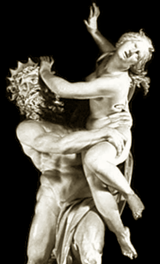...Best of Sicily presents... Best of Sicily Magazine. ... Dedicated to Sicilian art, culture, history, people, places and all things Sicilian. |
by Vincenzo Salerno | |||
Magazine Index Best of Sicily Arts & Culture Fashion Food & Wine History & Society About Us Travel Faqs Contact Map of Sicily
|
Persephone's courtship, by comparison, was a last minute affair, though she had little need for religious ceremonies. In mythology, she was the beautiful daughter of Zeus, king of the gods, and Demeter (Ceres), goddess of agriculture and fertility. While gathering flowers in the Valley of Enna, Persephone, who is also known as Kore (Greek for "maiden") was abducted by Hades and taken to the underworld. Having lost her daughter to this dark realm, Demeter descended into sorrow, losing interest in the mortals and their agriculture, and Zeus had to intervene to bring an end to the famine that resulted from this abandonment. This he did by ordering Hades to release Kore, but not before the maiden had consumed a pomegranate seed as a sign of fidelity to Hades. That meant that she had to spend at least four months of every year with Hades, by whom she had a son, Plutus. Kore became the goddess of grain (wheat), and her annual absence was meant to account for the barren winter fields. Her cult was widespread, particularly at Enna, and Lake Pergusa is sometimes identified as the place where she was abducted or raped by Hades. She appears in several Greek myths and was worshipped at Eleusis in Attica. The allegory of Persephone is timeless. Grain sprouts to life from the earth to be harvested by man in the same way that a nubile girl is taken from her parents and her virginity lost to bring forth new life. Persephone's case may have been rather extreme, but the principle is unchanged. Her story dates at least from 700 BC, when the first Greek colonies were established in Sicily. Enna is a very old city, and a temple to Demeter stood on the rocky mount near its Lombard Castle, overlooking the plains and mountains below. In his Hymn to Demeter, Homer recounts the story of Persephone. It is much embellished over time, with local versions featuring details unknown to the ancients. Persephone's renewal is not unlike nature's, and through the myth human life is said to imitate nature itself. The imagery and message are purely Greek, but the earliest legend may have been Sicilian. It has been suggested that Persephassa, an earlier name for Persephone, indicates a pre-Hellenistic origin, and possibly a Sicanian or Sicel one. This may explain the early existence of a cult to this goddess in east-central Sicily coinciding with the Greeks' first incursions into the region and their gradual amalgamation with the native peoples. To the Romans, she was Prosperina, and that is how she is known to Italians. Her Latin name shares the root of the word meaning "to prosper." About the Author: Palermo native Vincenzo Salerno has written biographies of several famous Sicilians, including Frederick II and Giuseppe di Lampedusa. | ||
Top of Page |
 Today, the typical young Sicilian woman stands about five feet five
inches. If not a goddess, she's shapely but not overweight, perhaps rather stylish, and spends most of July and August at the beach.
She finds her first employment of any kind at around twenty-six, following an interrupted year or two of
specialized higher education. In a sexist society, she's slightly left of center politically and opposes the death
penalty (which anyway doesn't exist in Italy). Having studied in Italy's schools, she believes that an Italian named
Meucci invented the telephone. A non-practicing Catholic, she nevertheless marries in a lavish religious ceremony at
thirty-two after a lengthy courtship.
Today, the typical young Sicilian woman stands about five feet five
inches. If not a goddess, she's shapely but not overweight, perhaps rather stylish, and spends most of July and August at the beach.
She finds her first employment of any kind at around twenty-six, following an interrupted year or two of
specialized higher education. In a sexist society, she's slightly left of center politically and opposes the death
penalty (which anyway doesn't exist in Italy). Having studied in Italy's schools, she believes that an Italian named
Meucci invented the telephone. A non-practicing Catholic, she nevertheless marries in a lavish religious ceremony at
thirty-two after a lengthy courtship.